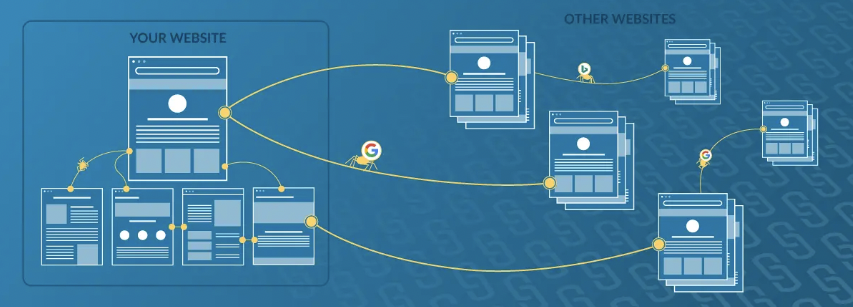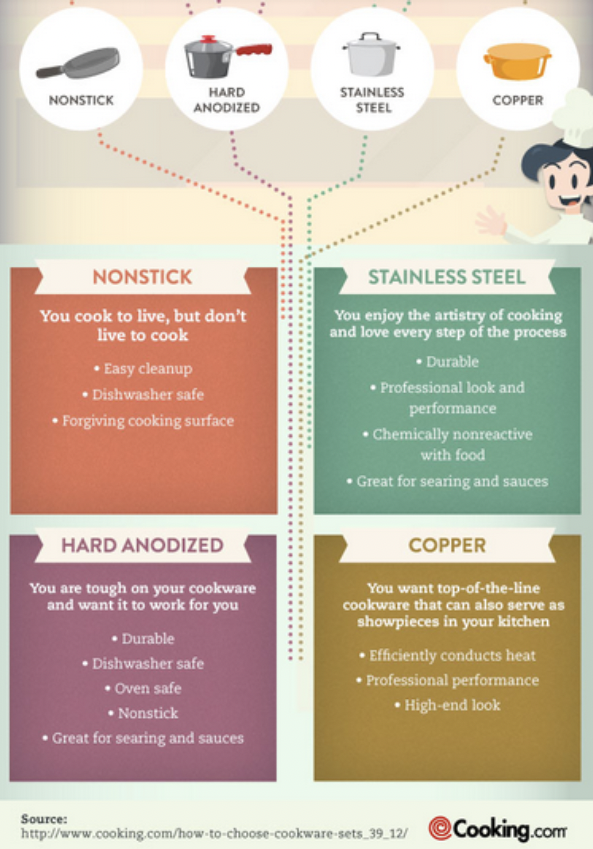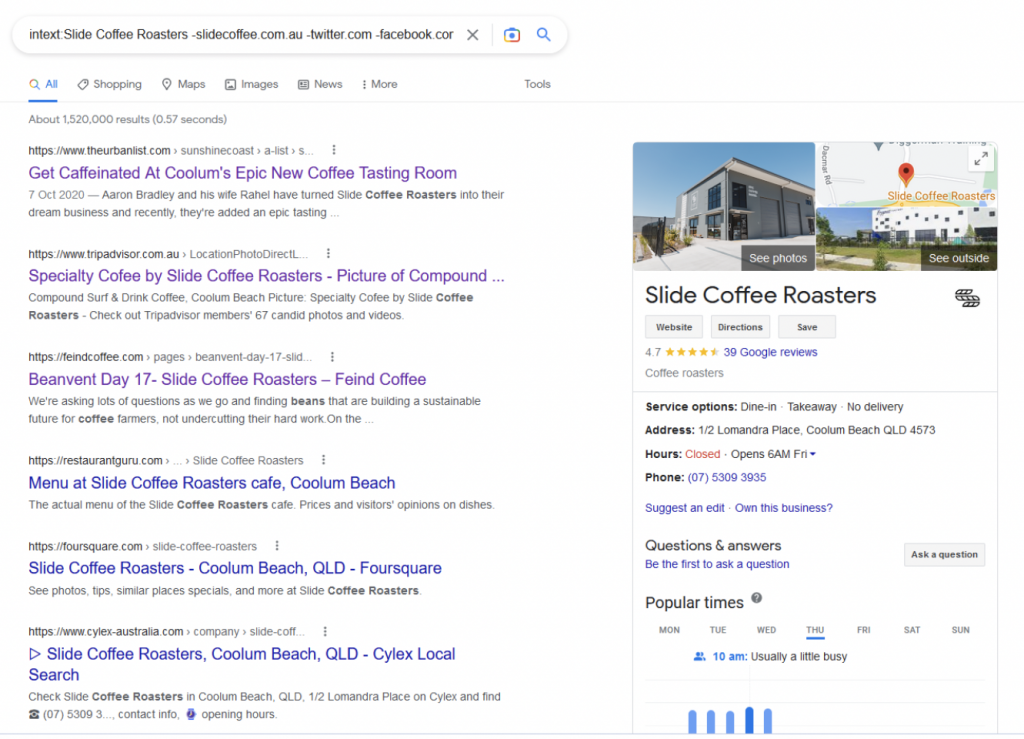Link building increases domain authority, improves keyword relevance, and helps you rank higher. Higher rankings drive more traffic that converts to sales.
Google's top three ranking factors are high quality content, great user experience, and links (Source: Search Engine Journal). In fact, websites with just 30 to 35 backlinks see over 10,500 monthly visits on average (uSERP).
This makes link building critical for eCommerce SEO success.
In this article, we’ll break down what link building is, the most effective eCommerce link strategies to get your site ranking faster, how to implement those strategies, and the key dos and don’ts to keep in mind.
What is Ecommerce link building?
Ecommerce link building gets other websites to link to your online store. Search engines view these backlinks as votes of confidence. More high-quality links mean higher rankings.
A backlink forms when another website links to yours. If a surfboard website links to your blog post about the best surfboards, you get a backlink.
Not all links are equal. Links from high-authority sites like Forbes or Ahrefs provide more value than unknown websites.

10 Most Effective Link Building Strategies for eCommerce Brands
1. Strategic Guest Posting
Strategic Guest Posting, also known as guest blogging, is when you write or update an article on someone else’s website or blog and include a link back to your own site.
How to Secure a Guest Post Backlink:
- Search for:
- keyword “guest post”
- Keyword “submit a guest post”
- Replace "keyword" with terms relevant to your niche (e.g., “eco-friendly skincare guest post”).
Step-by-Step Process:
- Research Potential Blogs
- Understand the blog’s content style, tone, and target audience.
- Check for relevance and recent topics to avoid duplicates.
- Craft a Compelling Pitch
- Read their guest post guidelines carefully.
- Personalise your outreach email—avoid generic templates.
- Mention your relevant writing experience and link to published posts.
- Suggest 2–3 well-thought-out article ideas tailored to their readers.
- Submit Your Guest Post
- Write a high-quality article that provides genuine value.
- Include one or two backlinks to your site.
- Add relevant images and a clear call-to-action where appropriate.
- Follow Up
- If you don’t hear back within 7–10 days, send a polite follow-up email.
- Track Your Progress
- Keep a spreadsheet to log outreach, follow-ups, published posts, and results (e.g. traffic, link status).
Watch this video to learn more:
2. Create linkable content
Build content that other websites want to link to. This includes guides, infographics, how-to articles, comparisons, reports, and FAQs.
Make your content solve real problems. Answer questions your customers ask. Provide better information than what's already online.
For example, if you sell cookware, create an infographic comparing different materials. Add an FAQ section covering:
- Which cookware is the healthiest?
- Best cookware for durability
- Stainless steel vs iron pros and cons
- Non-stick vs stainless steel comparison
Infographic example:

This type of content gets shared on social media and referenced by other websites.
3. Unlinked brand mentions
Find mentions of your brand online that don't link to your website. Contact the site owner and ask them to add a link.
The hard way: Use Google search: intext: "your brand name" -yourwebsite.com -twitter.com -facebook.com -pinterest.com -youtube.com -instagram.com
Example:
Let’s say your brand is Slide Coffee Roasters, and your website is slidecoffee.com.au.
To find unlinked mentions while excluding your site and social media pages, search:
intext:"Slide Coffee Roasters" -slidecoffee.com.au -twitter.com -facebook.com -pinterest.com -youtube.com -instagram.com
This will return a list of web pages that mention your brand but don’t link to your website, and aren't on major social platforms. These are great opportunities to reach out and request a backlink.

The easy way: Use Ahrefs or Buzzsumo to monitor brand mentions automatically.
When you find unlinked mentions, email the author and request a link. Don't ask if the mention is negative.
4. Coupons and Promo Codes
Submitting your coupon codes to deal websites is a simple but effective way to earn backlinks.
These sites often have high domain authority and can drive both traffic and SEO value.
How to Do It:
To build backlinks using Coupons and Promo Codes, search for submission opportunities using Google queries like:
- "submit coupon code"
- "your product keyword" inurl:submit-coupon
Example:
Search - “lighting inurl:submit-coupon”
Submit your promo codes to popular deal websites such as:
- Honey
- OzBargain
- Groupon
Bonus tips:
- Create a dedicated promo or discount landing page on your website. Use that page as the link destination when submitting your codes. This helps with both conversions and SEO.
- You can also reach out to niche deal blogs and ask them to feature your discounts as part of their seasonal roundups or product reviews.
5. Partnership with influencers
Partner with YouTubers, podcast hosts, bloggers, or companies in related industries.
The Affiliate Marketing Angle To Reach Influencers:
You might have heard of affiliate marketing tons of times! You can use this tactic to partner with bloggers and influencers to build brand awareness and increase conversions.
Find bloggers and influencers in your niche. Look for people with engaged audiences who aren't direct competitors.
Offer valuable commission rates. Create an affiliate program landing page with benefits, joining instructions, and terms.
Optimise the landing page so it can be discovered easily on search engines.
Promote your program through social media, paid ads, newsletters, and website menus.

6. Giveaways
Send your products to influencers for free in exchange for a review.
You already know the power of influencers. But how do you capitalise on this?
It's pretty simple, actually.
Find influencers with a reasonable followers.
Send them a short email encouraging them to try out your product.
You may not have to try hard to get a review as the influencer is most likely to create a video or a blog post talking about your product.
And that’s it… If you reach out to even 10 people and give away your product for free, you get 10 quality backlinks!
7. Podcasts
Use podcasts to promote your business and earn links.
Podcasts are a great way to promote your business. They are informative and educational for listeners. And they can add another dimension to your marketing strategy.
They are immensely popular - it’s easy to enter this space, and the material can be used on different mediums (audio and video). It can be a great tool to increase your website's authority and visibility.
How to do this?
Guest appearances: Talk about your business journey or industry topics. Podcasters often include guest websites in show notes.
Sponsorship: Sponsor podcast episodes. Podcasters mention sponsors in episodes and show notes. This works if your budget allows.
8. Local Listings and Niche Directories
Submit your business to local directories and industry-specific listings.
Start with Google My Business, Yelp, and local business directories.
Find industry-specific directories by searching "[your industry] directory Australia" or "[product type] retailer listings."
Contact your suppliers. Many manufacturers maintain "where to buy" pages. Email them asking to be listed.
9. Affiliate Programs
Set up a program where other websites earn commission for sending customers.
Offer 5-10% commission on sales. Use platforms like ShareASale or Commission Junction for tracking.
Target bloggers in your niche. Show them potential earnings. A blogger making $500/month from affiliates will respond to good opportunities.
Provide affiliates with marketing materials, product images, and promotional copy.
10. Product Reviews & Gift Guides
Get your products featured in reviews and holiday gift guides.
Send products to reviewers and bloggers. Many will review items in exchange for keeping the product.
Search "best [your product] 2025" to find review sites. Email authors directly: "Would you like to try our for an honest review?"
Target gift guide writers before holidays. They need fresh product ideas.
Build relationships with reviewers year-round, not just during busy seasons.
Additional Advanced Strategies
HARO (Help a Reporter Out)
HARO connects journalists with expert sources. Sign up at helpareporter.com as a source.
You'll receive three daily emails with reporter requests. Respond quickly when requests match your expertise.
Keep responses under 200 words. Include credentials and website. Most responses won't result in links, but successful ones come from high-authority news sites.
Broken Link Building
Find broken links on websites and suggest your content as replacement.
Use Ahrefs to find competitor backlinks with 404 errors. Email the linking site: "I noticed you link to [broken URL]. Our guide on [topic] covers similar information if you'd like to update the link."
This works because you help them fix their site while earning a link.
Competitor Link Analysis
Analyse where competitors get backlinks and target the same sources.
Use Ahrefs Backlink Analytics to see competitor link profiles. Look for:
- Recently lost links you could capture
- Resource pages that feature competitors
- Review sites covering competitor products
Email these sites suggesting your business as an addition or replacement.
Digital PR Campaigns
Create newsworthy stories that attract media attention and backlinks.
Product launches: Release unique or innovative products that generate press interest.
Charity work: Partner with causes or donate portions of profits. Many companies get featured for community involvement.
Research and surveys: Conduct industry research and share findings with relevant publications.
Seasonal campaigns: Create holiday-themed products or campaigns that media outlets want to cover.
Resource Page Link Building
Find pages that curate industry resources and request inclusion.
Search for:
- "useful links" AND [your industry]
- "[your industry] resources"
- "best [product type]"
- "[topic] roundup"
Contact page owners requesting inclusion. Show how your resource adds value to their list.
Internal Link Building
Link between pages on your own website to distribute link authority.
Connect blog posts to relevant product pages. Link product pages to related items. Create clear navigation paths for both users and search engines.
Use descriptive anchor text that tells users what they'll find on the linked page.
Link Building Rules
Link building requires strategy and patience. There are no shortcuts to high-quality backlinks.
Don't:
- Buy cheap backlinks - It is a spammy technique and your website can get penalised.
- Only link to your homepage - use blog pages, product pages, category pages or news pages. If only one page receives backlinks, it may look spammy and unnatural.
- Recycle the same content on different websites to get backlinks.
- Accept backlinks from websites with low reputations, low quality and irrelevant niches.
- Use generic anchor text like "click here". Make sure you are using the right keywords in your anchor text.
- Repeat the same anchor text constantly
- Expect immediate results
Do:
- Focus on quality over quantity
- Diversify your link sources
- Use descriptive anchor text
- Build relationships with other site owners
- Create genuinely valuable content
- Track your efforts and results
- Be patient and persistent
Key Takeaways
Outreach remains the most effective link building method. When contacting website owners, remember you're reaching real people with busy schedules.
Show genuine value. Explain why they should care about your request. Avoid spam-like emails.
Create content that naturally attracts links. The better your resources, the easier link building becomes.
Link building takes time and effort. Expect months, not weeks, to see significant results.
Track your progress with tools like Ahrefs or Semrush. Monitor both quantity and quality of acquired links.
Focus on building relationships, not just collecting links. Long-term partnerships generate more value than one-off transactions.
Need Help With Your eCommerce Link Building Strategy?
At Websites That Sell, we specialise in eCommerce SEO and link-building strategies that deliver results. If you’re ready to grow your traffic and rankings, get in touch with our team today.

